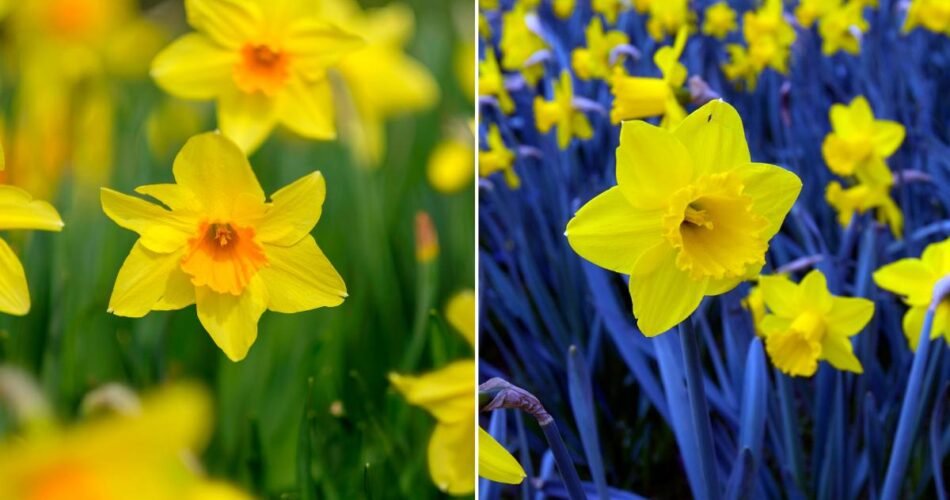What are the March birth flowers?
As we welcome March, the month that heralds the arrival of spring, we celebrate two bright and joyful birth flowers: the Daffodil and the Jonquil. These closely related flowers burst into blooms of vibrant yellows, embodying the essence of spring’s renewal, joy, and the promise of sunnier days ahead. Daffodils and Jonquils are symbols of new beginnings, making them perfect emblems for March.
In this blog post, we will delve into the fascinating world of birth month flowers, exploring their meanings, origins, and fascinating facts. We will also explore how these flowers inspire art, creativity, and thoughtful gift ideas. So, let’s embark on this floral journey and uncover the beauty and significance of March birth month flowers.
Related Post: Birth Flowers for all 12 months
History & Origin of Daffodils

Daffodils, known scientifically as Narcissus, have a rich history woven with mythology, medicinal uses, and cultural significance. The name “Narcissus” is believed to be derived from the Greek word ‘narke’, meaning numbness or stupor, referencing the narcotic properties of the plant. According to Greek mythology, the flower is named after the youth Narcissus, who became so enamored with his own reflection that he turned into a flower.
Daffodils have been associated with spring and rebirth for centuries, as they are among the first flowers to bloom as winter wanes. Their bright yellow color is reminiscent of the sun, which becomes increasingly present in March, making them a fitting symbol for this transitional month.
What does Daffodils mean?
Daffodils are not just a sign of spring; they carry deep meanings and symbolism. Traditionally, Daffodils signify rebirth and new beginnings, making them a perfect emblem for the renewal that spring brings. They are often associated with positivity, due to their bright yellow color that resembles the sun. In various cultures, Daffodils also symbolize prosperity, good luck, and happiness.
The color of the Daffodil can also influence its meaning:
- Yellow Daffodils, the most common, are linked to happiness, positivity, and the energy of the coming spring.
- White Daffodils represent purity, transformation, and a fresh start.




How to care for Daffodils
Daffodils are relatively low-maintenance and can thrive easily with some basic care:
- Planting: Daffodil bulbs should be planted in the fall, about 2 to 4 inches deep and 3 to 6 inches apart, in well-draining soil.
- Sunlight: They prefer full to partial sunlight. Planting them in a spot that receives at least 6 hours of sun a day is ideal.
- Watering: Daffodils need regular watering during the growing season, especially in the weeks leading up to the bloom. After flowering, you can reduce watering as the plant begins to die back.
- Soil: They thrive in moderately fertile, well-drained soil. Adding some compost at planting time can help improve soil conditions.
- Aftercare: Once Daffodils have finished blooming, it’s important to leave the foliage until it turns yellow and dies back naturally. The leaves are gathering energy for next year’s bloom, so cutting them back too early can weaken the bulb.
Interesting or less known facts about Daffodils
- Tenacity: Daffodils are known for their ability to push through the frozen ground and bloom early in spring, symbolizing resilience and determination.
- Cultural Icon: In Wales, the Daffodil is a national symbol, worn on St. David’s Day. According to legend, wearing a Daffodil on this day brings good luck.
- Literary Fame: The Daffodil has been immortalized in literature, most notably in William Wordsworth’s poem “I Wandered Lonely as a Cloud,” which celebrates the joy and beauty of a field of Daffodils.
- Medicinal Use: Despite their beauty, Daffodil bulbs contain alkaloids that have been used in traditional medicine, though they are toxic if ingested without proper preparation.
History & Origin of Jonquils
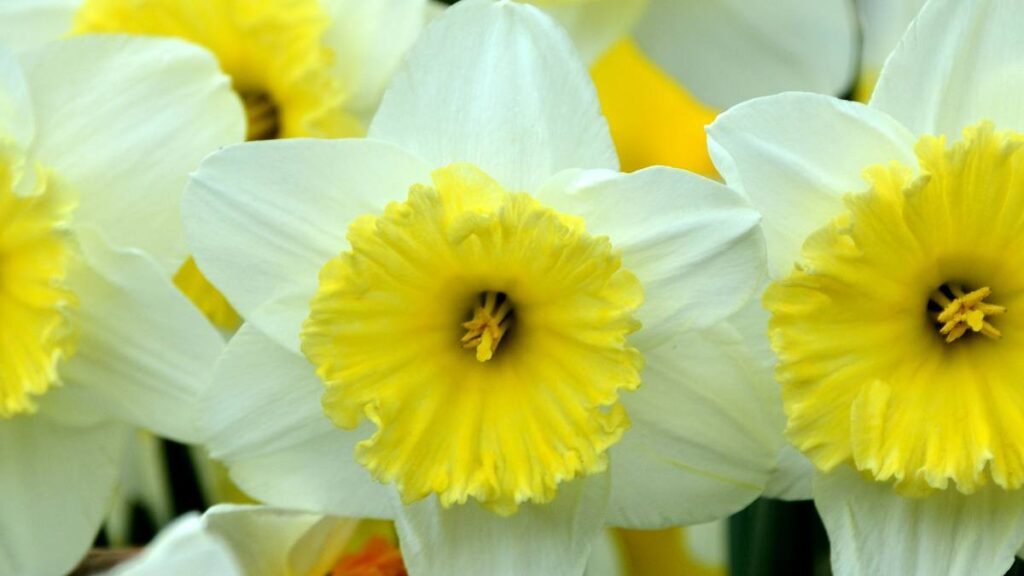
Jonquils, a type of Narcissus closely related to Daffodils, are characterized by their sweet fragrance and clusters of small, yellow flowers. The name “Jonquil” is derived from the Spanish word jonquillo, which refers to the rush-like leaves of the plant, similar to the reed Juncus.
Jonquils have been cultivated since ancient times, with their origins tracing back to the Mediterranean. They were brought to England in the 17th century and quickly became a garden favorite for their heady scent and early spring blooms. The association of Jonquils with March is largely due to their blooming period, which aligns with the early days of spring, symbolizing the end of winter and the promise of renewal and growth.
What does Jonquils mean?
Jonquils carry a bouquet of meanings, deeply rooted in symbolism and tradition. These cheerful blooms primarily symbolize desire, affection returned, and the joys of life, making them perfect for expressing love and appreciation. Their vibrant yellow hue echoes themes of warmth, friendship, and happiness.
In the language of flowers, Jonquils are often given as a token of affection, suggesting “You bring joy to my life” or “I desire a return of affection.” They are a wonderful way to convey warm feelings and wishes for happiness to the recipient.
How to care for Jonquils
Jonquils are delightful spring flowers that are relatively easy to care for, ensuring their bright blooms grace your garden year after year:
- Soil: Jonquils prefer well-drained, moderately fertile soil. They thrive in soil that’s slightly acidic to neutral.
- Planting: Plant Jonquil bulbs in the fall, 6-8 weeks before a hard frost is expected. Bulbs should be planted about 6 inches deep and 4 inches apart.
- Sunlight: These flowers enjoy full sun to partial shade. An area that receives direct sunlight for most of the day is ideal.
- Watering: Keep the soil moist, but not waterlogged, during the growing season. Once established, Jonquils are quite drought-tolerant.
- Aftercare: After blooming, allow the foliage to remain until it turns yellow and dies back naturally. This process helps the plant store energy for the next blooming season. Avoid cutting back the foliage until it has died down naturally.
Interesting or less known facts about Jonquils
- Fragrance Powerhouse: Jonquils are renowned for their strong, sweet fragrance, which is more intense than that of many other Narcissus varieties. This makes them a favorite for perfumery and scented gardens.
- Symbol of Wealth: In some cultures, Jonquils are considered symbols of wealth and prosperity, likely due to their lush, golden blooms.
- Historical Remedies: Historically, Jonquils were used in traditional medicine, particularly for their oil, which was believed to relieve coughs and colds. However, caution is advised as all parts of the plant can be toxic if ingested improperly.
March Birth Flower Comparison
| Month | Birth Flower | Characteristics | Symbolism |
|---|---|---|---|
| March | Daffodil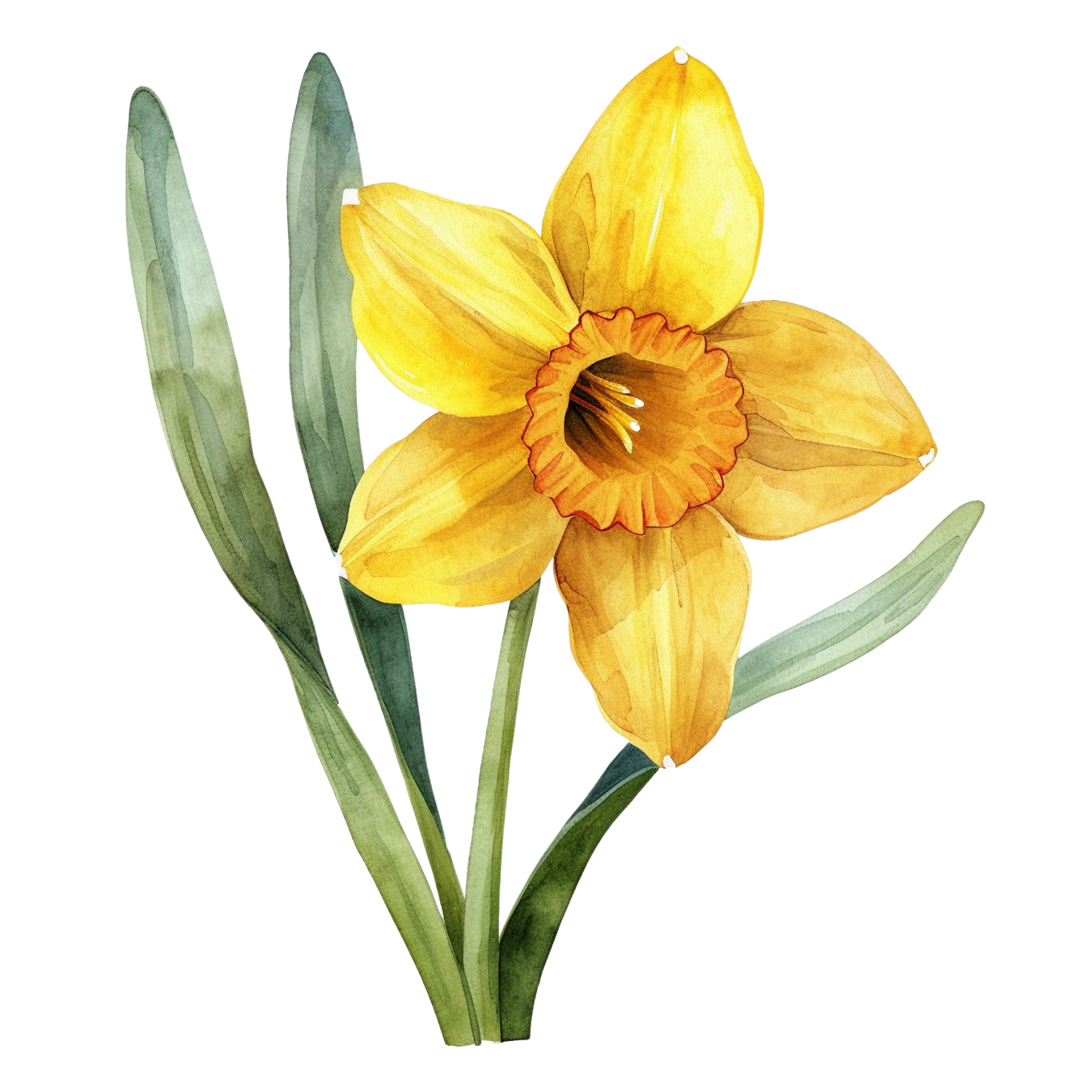 | Bright yellow flowers, trumpet-shaped center | New beginnings, prosperity, rebirth |
Jonquils | Bright yellow, sweetly scented, trumpet-shaped flowers | Desire, affection, the return of happiness |
What are the popular March birth flower gifts?
Celebrating March birthdays or simply embracing the spirit of spring can be wonderfully expressed through gifts featuring Daffodils and Jonquils:
- Bouquets and Floral Arrangements: A vibrant bouquet combining Daffodils and Jonquils can brighten any room and bring the joy of spring indoors.
- Potted Plants: Gifting a potted Daffodil or Jonquil plant allows the recipient to enjoy the blooms indoors and can be replanted outdoors for yearly enjoyment.
- Garden Kits: For those who love to garden, a kit with Daffodil and Jonquil bulbs can be a thoughtful gift, providing them with the joy of planting and watching the flowers bloom.
- Themed Merchandise: From scented candles capturing the intoxicating aroma of Jonquils to art prints and stationery adorned with Daffodil motifs, themed merchandise offers a lasting reminder of the beauty of March’s birth flowers.
Here are some more gift ideas featuring March’s birth flowers to explore.


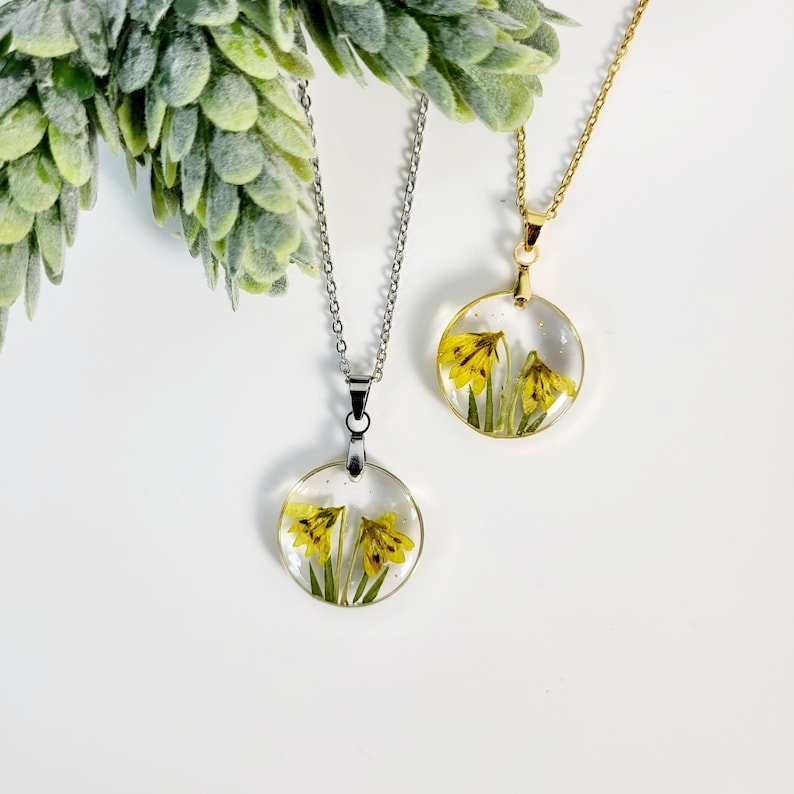


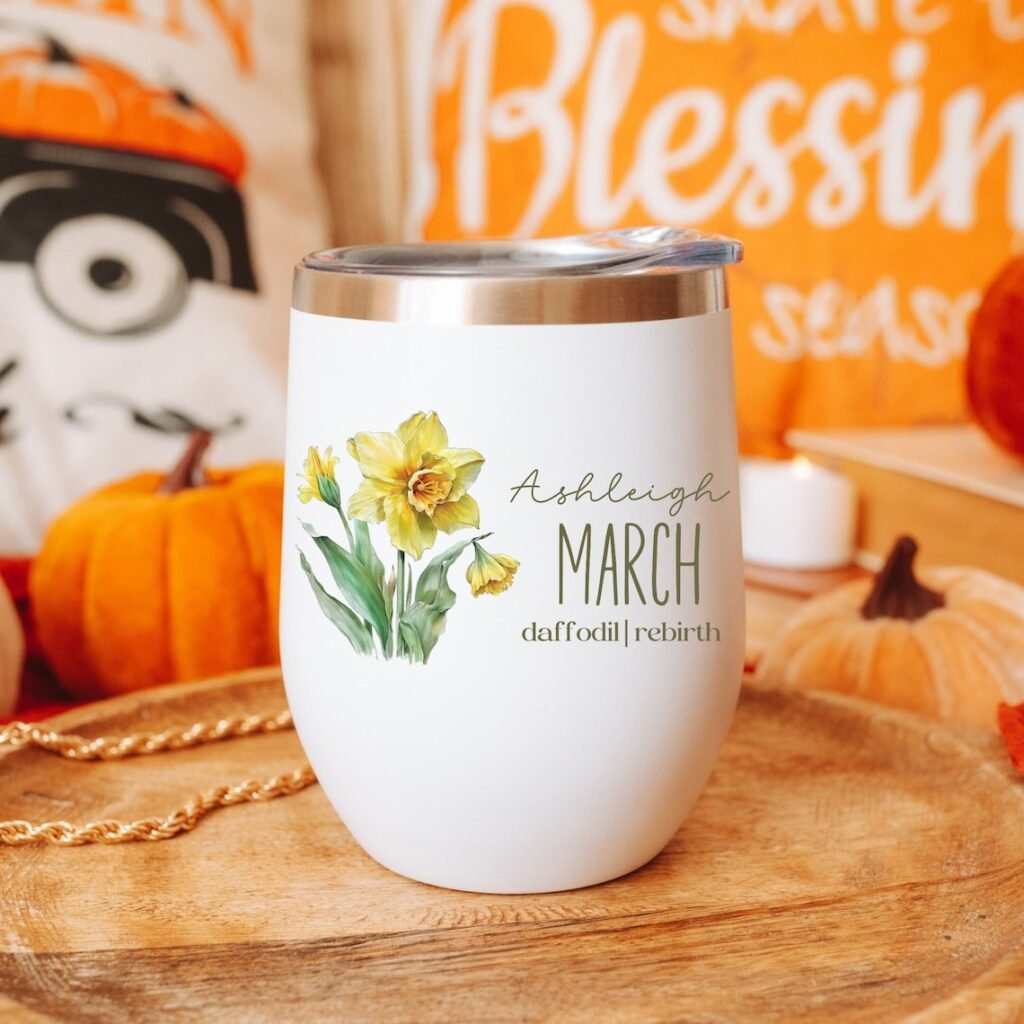
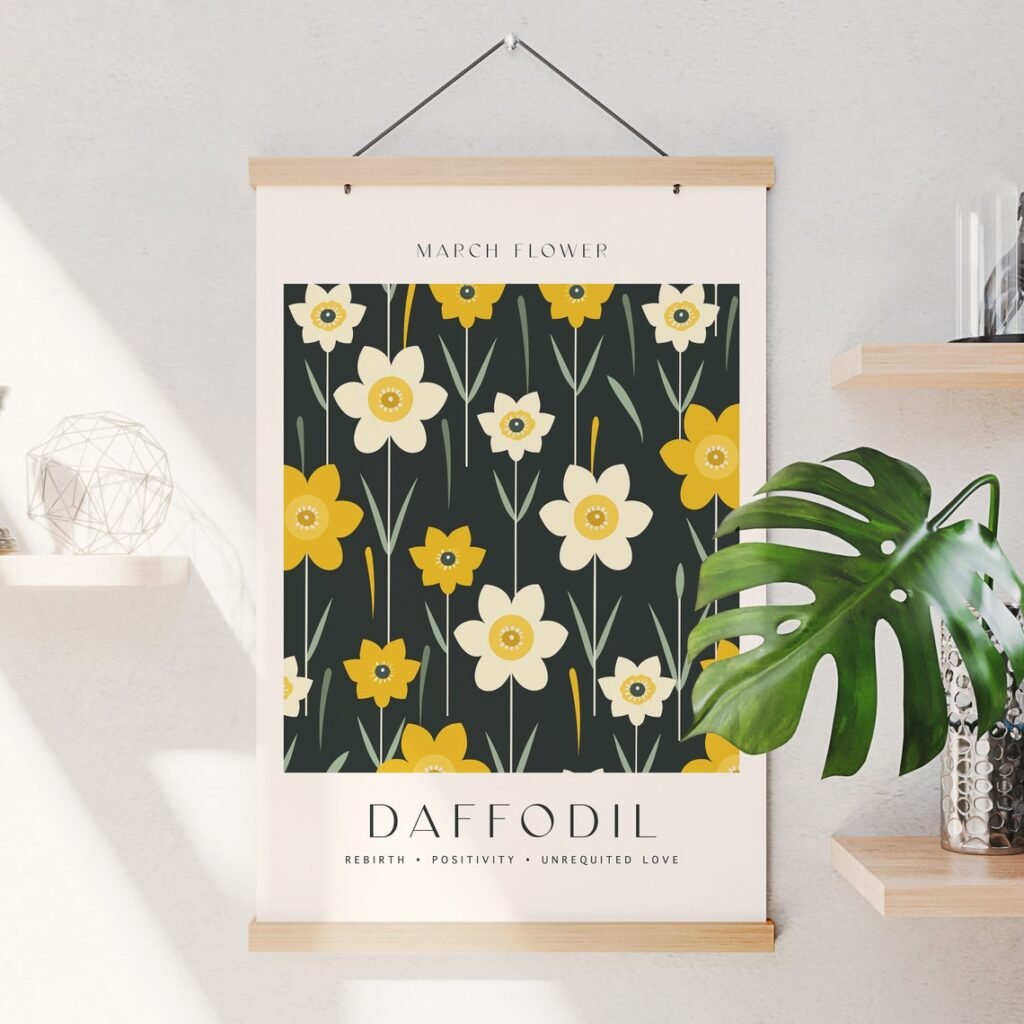

What are some artistic or creative applications of March birth flower gifts?
Daffodils and Jonquils, with their bright hues and cheerful disposition, inspire a wide range of artistic and creative applications:
- Art and Illustration: These flowers make beautiful subjects for watercolor paintings, sketches, and digital art, capturing the essence of spring.
- Home Decor: Incorporate Daffodil and Jonquil motifs into home decor through floral arrangements, wall art, cushion covers, or table settings for a touch of spring.
- Personal Accessories: Jewelry pieces inspired by Daffodil and Jonquil shapes and colors can add a unique and meaningful touch to any outfit.
- Tattoos: For a more permanent homage, tattoos of Daffodils or Jonquils can symbolize new beginnings, hope, and the joy of life, making them a popular choice for body art.
Conclusion
March’s birth flowers, Daffodils and Jonquils, are not just heralds of spring; they are emblems of rejuvenation, new beginnings, and the enduring joy of life. Their vibrant yellow blooms remind us of the sun’s return and the warmth it brings. Embracing these flowers, whether in gardens, as gifts, or through artistic expressions, allows us to celebrate the transition from winter to spring and the continuous cycle of life. Let’s cherish and share the beauty of Daffodils and Jonquils, spreading their message of hope and happiness.
10 FAQs
What are the birth flowers for March?
Daffodils and Jonquils.
What do Daffodils symbolize?
Rebirth, new beginnings, and unrequited love.
What is the meaning behind Jonquils?
Desire, affection returned, and the joys of life.
Can I grow Daffodils indoors?
Yes, Daffodils can be forced to bloom indoors in pots.
Are Jonquils and Daffodils the same?
Jonquils are a type of Daffodil, characterized by their fragrance and multiple flowers per stem.
How long do Daffodil blooms last?
Typically, Daffodil blooms last up to 6 weeks, depending on the variety and environmental conditions.
Can Jonquils survive frost?
Yes, Jonquils are hardy and can survive late winter frosts.
Are Daffodils toxic to pets?
Yes, Daffodils contain compounds that are toxic to most pets if ingested.
When should I plant Daffodil bulbs?
Plant Daffodil bulbs in the fall, about 2 to 4 weeks before the ground freezes.
How can I use Daffodils in a bouquet without harming other flowers?
Daffodils secrete a sap that can harm other flowers, so initially, keep them in a separate vase for at least 24 hours before combining them with other blooms.

